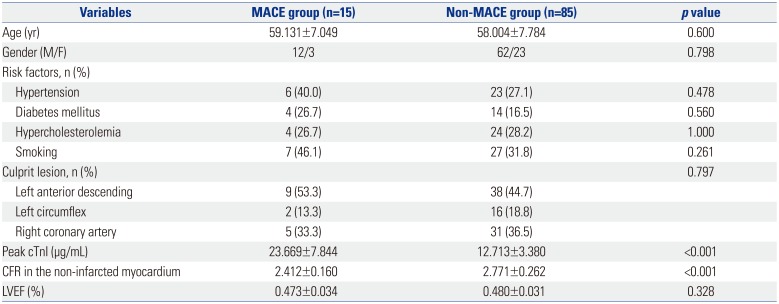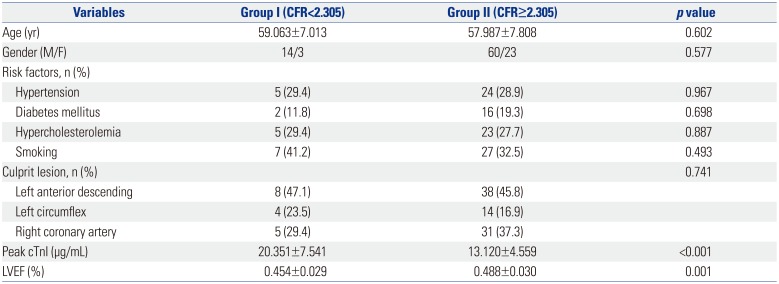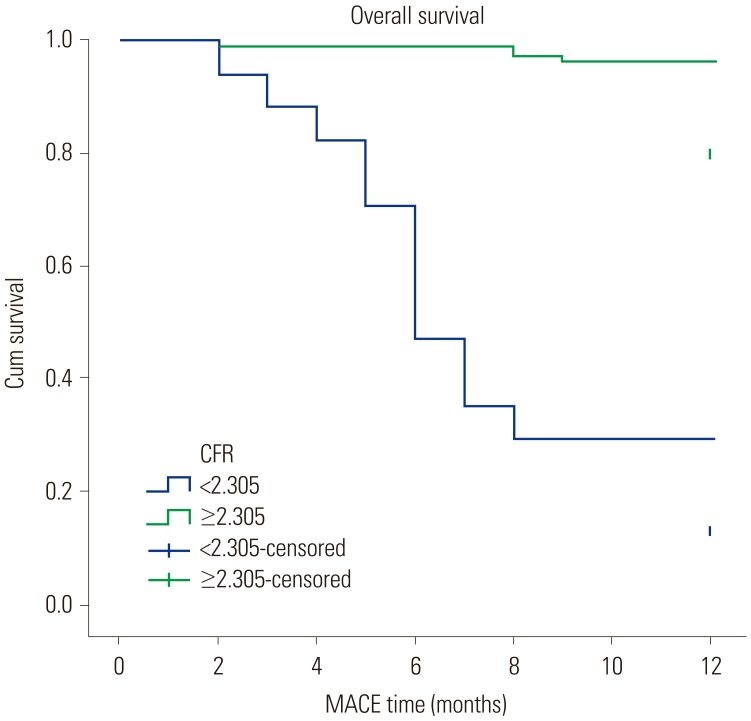1. Bowers TR, O'Neill WW. Coronary rotablation and reserve: can they occur together. Cathet Cardiovasc Diagn. 1995; 36:277. PMID:
8542642.

2. Bierig SM, Mikolajczak P, Herrmann SC, Elmore N, Kern M, Labovitz AJ. Comparison of myocardial contrast echocardiography derived myocardial perfusion reserve with invasive determination of coronary flow reserve. Eur J Echocardiogr. 2009; 10:250–255. PMID:
18723849.

3. Kisanuki A, Yuasa T, Kuwahara E, Takasaki K, Yoshifuku S, Otsuji Y, et al. Reproducibility of intravenous intermittent triggered myocardial contrast echocardiography in healthy subjects. Jpn Heart J. 2004; 45:461–473. PMID:
15240966.

4. Kaul S. Myocardial contrast echocardiography: basic principles. Prog Cardiovasc Dis. 2001; 44:1–11. PMID:
11533923.

5. Wita K, Filipecki A, Lelek M, Bochenek T, Elžbieciak M, Wróbel W, et al. Prediction of left ventricular remodeling in patients with STEMI treated with primary PCI: use of quantitative myocardial contrast echocardiography. Coron Artery Dis. 2011; 22:171–178. PMID:
21394026.
6. Porter TR, D’Sa A, Turner C, Jones LA, Minisi AJ, Mohanty PK, et al. Myocardial contrast echocardiography for the assessment of coronary blood flow reserve: validation in humans. J Am Coll Cardiol. 1993; 21:349–355. PMID:
8425997.

7. Swinburn JM, Lahiri A, Senior R. Intravenous myocardial contrast echocardiography predicts recovery of dysynergic myocardium early after acute myocardial infarction. J Am Coll Cardiol. 2001; 38:19–25. PMID:
11451273.

8. Mengozzi G, Rossini R, Palagi C, Musumeci G, Petronio A, Limbruno U, et al. Usefulness of intravenous myocardial contrast echocardiography in the early left ventricular remodeling in acute myocardial infarction. Am J Cardiol. 2002; 90:713–719. PMID:
12356383.
9. Yamamuro A, Akasaka T, Tamita K, Yamabe K, Katayama M, Takagi T, et al. Coronary flow velocity pattern immediately after percutaneous coronary intervention as a predictor of complications and in-hospital survival after acute myocardial infarction. Circulation. 2002; 106:3051–3056. PMID:
12473550.

10. Camici PG, Crea F. Coronary microvascular dysfunction. N Engl J Med. 2007; 356:830–840. PMID:
17314342.

11. Wu JC, Yun JJ, Dione DP, Heller EN, Deckelbaum LI, Sinusas AJ. Severe regional ischemia alters coronary flow reserve in the remote perfusion area. J Nucl Cardiol. 2000; 7:43–52. PMID:
10698234.

12. Kern MJ, Bach RG, Mechem CJ, Caracciolo EA, Aguirre FV, Miller LW, et al. Variations in normal coronary vasodilatory reserve stratified by artery, gender, heart transplantation and coronary artery disease. J Am Coll Cardiol. 1996; 28:1154–1160. PMID:
8890809.

13. Bokor D. Diagnostic efficacy of SonoVue. Am J Cardiol. 2000; 86:19–24.

14. Eliasen P, Amtorp O. Effect of intracoronary adenosine upon regional blood flow, microvascular blood volume and hematocrit in canine myocardium. Int J Microcirc Clin Exp. 1984; 3:3–12. PMID:
6480228.
15. Wei K, Jayaweera AR, Firoozan S, Linka A, Skyba DM, Kaul S. Quantification of myocardial blood flow with ultrasound-induced destruction of microbubbles administered as a constant venous infusion. Circulation. 1998; 97:473–483. PMID:
9490243.

16. Tiemann K, Pohl C, Schlosser T, Goenechea J, Bruce M, Veltmann C, et al. Stimulated acoustic emission: pseudo-Doppler shifts seen during the destruction of nonmoving microbubbles. Ultrasound Med Biol. 2000; 26:1161–1167. PMID:
11053751.

17. Kaul S. Myocardial contrast echocardiography: 15 years of research and development. Circulation. 1997; 96:3745–3760. PMID:
9396479.
18. Galiuto L, Garramone B, Scarà A, Rebuzzi AG, Crea F, La Torre G, et al. The extent of microvascular damage during myocardial contrast echocardiography is superior to other known indexes of post-infarct reperfusion in predicting left ventricular remodeling: results of the multicenter AMICI study. J Am Coll Cardiol. 2008; 51:552–559. PMID:
18237684.
19. Yang L, Xia C, Mu Y, Guan L, Wang C, Tang Q, et al. Prognostic value of real time myocardial contrast echocardiography after percutaneous coronary intervention. Echocardiography. 2016; 33:421–430. PMID:
26411872.

20. Duffy BK, Gurm HS, Rajagopal V, Gupta R, Ellis SG, Bhatt DL. Usefulness of an elevated neutrophil to lymphocyte ratio in predicting long-term mortality after percutaneous coronary intervention. Am J Cardiol. 2006; 97:993–996. PMID:
16563903.

21. Aoki H, Matsunari I, Nomura Y, Fujita W, Komatsu R, Miyazaki Y, et al. Myocardial sympathetic innervation, function, and oxidative metabolism in non-infarcted myocardium in patients with prior myocardial infarction. Ann Nucl Med. 2013; 27:523–531. PMID:
23494212.

22. Feldman RL, Macdonald RG, Nichols WW, Conti CR, Pepine CJ. Effects of acute coronary occlusion on hemodynamics in an adjacent coronary artery in dogs. Am J Cardiol. 1984; 54:1103–1107. PMID:
6496331.

23. Uren NG, Crake T, Lefroy DC, de Silva R, Davies GJ, Maseri A. Reduced coronary vasodilator function in infarcted and normal myocardium after myocardial infarction. N Engl J Med. 1994; 331:222–227. PMID:
7832835.

24. Neizel M, Futterer S, Steen H, Giannitsis E, Reinhardt L, Lossnitzer D, et al. Predicting microvascular obstruction with cardiac troponin T after acute myocardial infarction: a correlative study with contrast-enhanced magnetic resonance imaging. Clin Res Cardiol. 2009; 98:555–562. PMID:
19582365.

25. de Boer RA, Pinto YM, Suurmeijer AJ, Pokharel S, Scholtens E, Humler M, et al. Increased expression of cardiac angiotensin II type 1 (AT(1)) receptors decreases myocardial microvessel density after experimental myocardial infarction. Cardiovasc Res. 2003; 57:434–442. PMID:
12566116.
26. Tsai CF, Ueng KC, Wu DJ, Tsai TP, Lin CS. Remodeled left ventricular myocardium remote to infarction sites is the arrhythmogenic substrate for sudden cardiac death. Med Hypotheses. 2010; 75:368–371. PMID:
20399566.

27. Bekkers SC, Yazdani SK, Virmani R, Waltenberger J. Microvascular obstruction: underlying pathophysiology and clinical diagnosis. J Am Coll Cardiol. 2010; 55:1649–1660. PMID:
20394867.
28. Mayer S, Grayburn PA. Myocardial contrast agents: recent advances and future directions. Prog Cardiovasc Dis. 2001; 44:33–44. PMID:
11533925.









 PDF
PDF ePub
ePub Citation
Citation Print
Print





 XML Download
XML Download